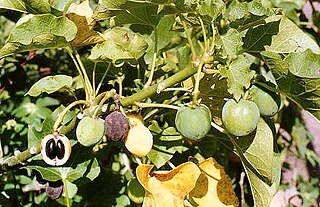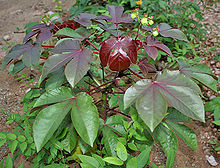
Biofuel is a fuel that is produced over a short time span from biomass, rather than by the very slow natural processes involved in the formation of fossil fuels such as oil. Biofuel can be produced from plants or from agricultural, domestic or industrial biowaste. Biofuels are mostly used for transportation, but can also be used for heating and electricity. Biofuels are regarded as a renewable energy source. The use of biofuel has been subject to criticism regarding the "food vs fuel" debate, varied assessments of their sustainability, and ongoing deforestation and biodiversity loss as a result of biofuel production.

Biodiesel is a renewable biofuel, a form of diesel fuel, derived from biological sources like vegetable oils, animal fats, or recycled greases, and consisting of long-chain fatty acid esters. It is typically made from fats.

Croton is an extensive plant genus in the spurge family, Euphorbiaceae. The plants of this genus were described and introduced to Europeans by Georg Eberhard Rumphius. The common names for this genus are rushfoil and croton, but the latter also refers to Codiaeum variegatum. The generic name comes from the Greek κρότος, which means "tick" and refers to the shape of the seeds of certain species.

Sebastiania is a genus of flowering plants in the family Euphorbiaceae first described in 1821. It is native to North and South America from Arizona and the West Indies south to Uruguay.

Macaranga is a large genus of Old World tropical trees of the family Euphorbiaceae and the only genus in the subtribe Macaranginae. Native to Africa, Australasia, Asia and various islands of the Indian and Pacific Oceans, the genus comprises over 300 different species. It was first described as a genus in 1806, based on specimens collected on the Island of Mauritius.

Claoxylon is a flowering plant genus in the spurge family, Euphorbiaceae, comprising dioecious subshrubs to small trees. It was first described as a genus in 1824. The genus is distributed in paleotropical areas: Madagascar through South and Southeast Asia, Malesia to Melanesia, Hawaiʻi, and Australia. Half of the species are in Malesia.

Manihot is a genus in the diverse milkspurge family, Euphorbiaceae. It was described as a genus in 1754.

Baccaurea is a genus of flowering plants belonging to the family Phyllanthaceae. The genus comprises 51 species, distributed from India to Indochina, southern China, Malesia, New Guinea, and the West Pacific. It is dioecious, with male and female flowers on separate plants. Many species contain edible fruits.

This article describes the use and availability of biodiesel in various countries around the world.

Biofuel development in India centres mainly around the cultivation and processing of Jatropha plant seeds, which are very rich in oil, ranging from 27 to 40%, and averaging 34.4%. The drivers for this are historic, functional, economic, environmental, moral and political.
Pongamia oil is derived from the seeds of the Millettia pinnata tree, which is native to tropical and temperate Asia. Millettia pinnata, also known as Pongamia pinnata or Pongamia glabra, is common throughout Asia and thus has many different names in different languages, many of which have come to be used in English to describe the seed oil derived from M. pinnata; Pongamia is often used as the generic name for the tree and is derived from the genus the tree was originally placed in. Other names for this oil include honge oil, kanuga oil, karanja oil, and pungai oil.

Jatropha curcas is a species of flowering plant in the spurge family, Euphorbiaceae, that is native to the American tropics, most likely Mexico and Central America. It is originally native to the tropical areas of the Americas from Mexico to Argentina, and has been spread throughout the world in tropical and subtropical regions around the world, becoming naturalized or invasive in many areas. The specific epithet, "curcas", was first used by Portuguese doc Garcia de Orta more than 400 years ago. Common names in English include physic nut, Barbados nut, poison nut, bubble bush or purging nut. In parts of Africa and areas in Asia such as India it is often known as "castor oil plant" or "hedge castor oil plant", but it is not the same as the usual castor oil plant, Ricinus communis.
Indian cassava mosaic virus(ICMV) is a plant pathogenic virus of the family Geminiviridae. It affects cassava (Manihot esculenta) in India and certain other countries. It is considered to be an invasive species.

Jatropha podagrica is a species of flowering, caudiciform succulent plant in the spurge family,Euphorbiaceae, aligning it closely with related genera such as Croton, Euphorbia and Ricinus, among others. It is native to the neotropics of Central America and southern Mexico, but is grown as an ornamental plant in many parts of the world due to its unusual appearance and mature caudex development. Common names for the species include gout-plant, gout-stalk, Guatemalan rhubarb, coral-plant, Buddha-belly plant, purging-nut, physic-nut, goutystalk nettlespurge, Australian bottleplant and tartogo.

Sustainable biofuel is biofuel produced in a sustainable manner. It is not based on petroleum or other fossil fuels. It includes not using plants that are used for food stuff to produce the fuel thus disrupting the world's food supply.

SG Biofuels is a privately held bioenergy crop company, which grows and researches Jatropha curcas for the production of biodiesel, bio jet fuel, and specialty chemicals.

Global Clean Energy Holdings (OTC:GCEH) is a Southern California-based renewable energy company with interests in the production and commercialization of non-food-based feedstocks used for the production of biofuels, biomass, and renewable chemicals. It was founded in 2007.

Bart Muys is a Belgian professor of forest ecology and forest management at the KU Leuven. His research focuses on the ecosystem functioning of tree diversity, the ecology of forest restoration and the evaluation of sustainability in forests and bioenergy systems. He is one of the most cited scientists internationally in the field of silviculture and forest management.

































